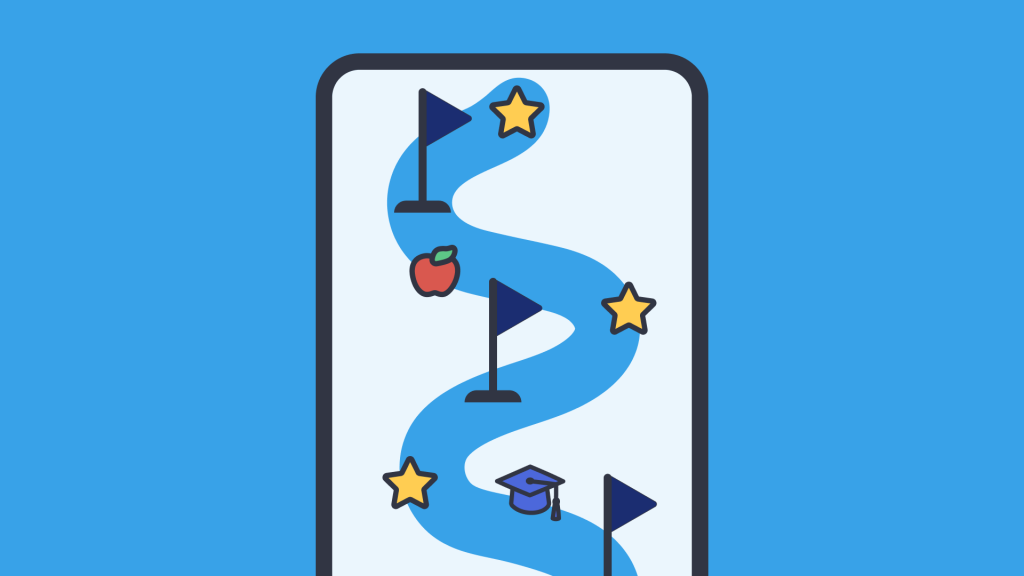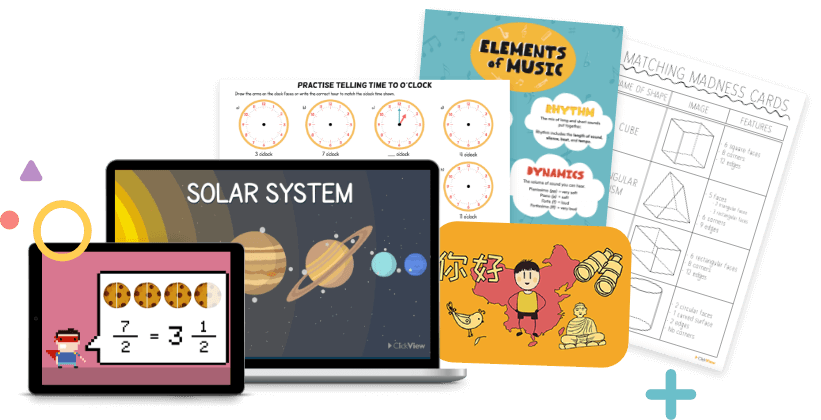4 Examples Of Gamification In Education
In the dynamic landscape of education, today’s students straddle the tail end of Generation Z and the dawn of Generation Alpha. These students have for the most part grown up with a device in their hands, playing games of some kind, watching videos, or somehow digitally engaged for as long as many may remember. These generations have also grown up with hyper-personalized and on-demand content, recommended videos, games, movies, and TV shows.
Conversations with educators about these learners often revolve around the shared observation that these generations harbour a deep affection for games—be they video games, role-playing adventures, building simulations, or immersive virtual realities. Frequently, educators discuss the perceived shortening of attention spans, with some studies suggesting spans as brief as eight seconds (Vizcaya-Moreno & Pérez-Cañaveras, 2022). However, it is these very same students who will spend an hour or more engaged in video game play. In a 2021 survey conducted by Common Sense Media 8-12 year olds children on average play about 90 minutes of video games per day and 13-18 year olds play about 105 minutes of video games per day. (Common Sense Media, 2022 pp. 9-10)
So, we must ask ourselves, are attention and engagement the same thing? Neil A. Bradbury (2023) states, “Although the two concepts are related, they are nonetheless distinct. As an educator, if you have your students’ attention, you can pour information into them; but if you have their engagement, they are actively craving content from you.” Instead of attributing a perceived lack of attention span to these students, the real challenge may lie in discovering innovative methods to engage them in the learning process. What if, by integrating principles of game design, we could unlock educational avenues that resonate with the distinct preferences of today’s learners?
What Is Gamification In Education?
Gamification in education entails incorporating elements of game design to enrich lessons and learning experiences. Key features encompass achievement through badges, rewards such as bonuses, dynamic action tied to objectives or narratives, personalization using avatars, and the integration of time-based elements like countdowns. The mere inclusion of any one of these elements, even outside the framework of a conventional game, transforms your lesson into a gamified experience. However, implementing gamification in the classroom can vary widely in terms of costs and time commitments. In the following sections, I will delve into diverse options, their associated time requirements, and the potential costs involved.
Benefits Of Gamification In Learning
Gamification in learning yields a wide range of advantages. According to Kirykova et al. (2014), the integration of game mechanics enhances the acquisition of new skills by an impressive 40%, fostering a higher level of commitment and motivation among users engaged in various activities and processes. Beyond the general enhancement of skill acquisition, distinct gamification features provide unique benefits:
Badges: Bestow players with the gratification of achievement and instil motivation for upcoming tasks.
Bonuses: Fuel player motivation while providing acknowledgement for successfully completed tasks.
Story: Immerse players in a narrative-rich experience, often with choices, thereby intensifying engagement and motivation.
Avatars: Cater to individual player preferences, significantly boosting engagement and motivation.
Countdowns: Infuse a sense of urgency, contributing to heightened focus and concentration among players.

Examples Of Gamification In Education
Classcraft Online Gamification Program
Classcraft (classcraft.com) stands out as a comprehensive online gamification program. According to the platform’s website, Classcraft’s motivational approach is deeply grounded in the Self-Determination Theory, a well-researched psychological framework. This theory posits that meeting players’ needs for control, competency development, and a sense of relatedness create significant pathways for fostering intrinsic motivation through external systems like gaming. Noteworthy is the availability of both free and paid versions of Classcraft, coupled with excellent support and data features. Teachers using Classcraft can not only encourage positive behaviours in their classrooms but also design and reward quests, comprising objectives or assignments. Students, in turn, enjoy the opportunity to personalize avatars, acquire gear, earn rewards, and even train virtual pets.
While the setup of Classcraft may demand a financial and time commitment, the potential rewards far exceed the costs incurred. Just imagine being able to incentivise and reward positive behaviour (Teaching Standard 7), adapt learning (Teaching Standard 5), create fun assessments (Teaching Standard 6), increase student and parent engagement, foster socio-emotional learning, and collect data (Teaching Standard 6) all in one tool.
Listen to a podcast interviews I did with Shawn Young, founder of Classcraft Episode 79, Episode 80, and Episode 82
Badge System In The Classroom
Implementing a badge system is one of the simplest and most cost-effective forms of gamification in my experience. Badges, requiring minimal time and often no financial investment, serve as a powerful tool to maintain high levels of satisfaction and motivation, especially when students are working at their own pace. I have successfully integrated badge systems across various grade levels, from 3rd to 8th, consistently witnessing a notable increase in student engagement and motivation.
Setting up a badge system is straightforward. Begin by creating a Google Slide presentation featuring a table on each slide, with columns for each student’s first name and the badges they can earn. Utilise design tools such as Canva, Adobe Express, or Google Draw to craft visually appealing badges, either by yourself or by involving students in the creative process. Restrict the number of badges to maintain focus, typically limiting it to 7 or 8.
In the first row of the table, list all the badges students can potentially earn. Once the badges and student names are in place, publish the slide presentation on the web and share the link with students. This allows them to track their progress, fostering a sense of accomplishment. Importantly, only you retain the ability to copy and paste badges as they are earned, adding an element of recognition and control.
The implementation of a badge system often fulfils all three of the components of Self-Determination Theory. One, autonomy, students feel in control of their behaviour and goals by knowing what to do in order to earn badges. Two, competence, students know their actions will impact shaping success by earning a badge. Finally, all students can celebrate each other’s success when earning badges. This all leads to heightened motivation among students, encouraging them not only to earn badges but also to monitor their progress actively. In some instances, healthy competition emerges as students strive to be the first to complete all the badges, creating a dynamic and engaging learning environment.
Slide used for tracking progress of a work-at-your-own-pace book link: Splat 3D Badge Tracker
![]()
Slide used for tracking progress of a work at your own pace book link: Splat 3D Badge Tracker
Storytelling As Gamification
Storytelling emerges as a powerful and cost-effective tool for gamification, requiring a blend of time and creativity with little to no financial commitment. Its versatility makes storytelling appropriate in areas where engagement and motivation might be lacking, and it can be seamlessly integrated into various subjects. Imagine being able to transport a student to a time and place where they feel like they are part of the story and recall is enhanced. According to Landrum et al. (2019):
neuroscience researchers suggest that our brains actually respond to what is happening in a story as if it were a genuine experience. …Our limbic system, mirror neu-rons, neurotransmitters, and cortical pathways are all engaged. Our experience of narrative transportation is tangible; as far as many areas of our brains are concerned, we do indeed enter that other world of the story. (pp. 249-250).
A noteworthy example is Randy, a physical education teacher I collaborate with, who elevates storytelling to an extraordinary level.
In a space-challenged environment, Randy crafts epic quests for his students, complete with music, levelling up mechanisms, characters, and engaging activities. One of his imaginative quests revolves around a captured strawberry held hostage by Prince Cardio in a mansion named The Peloton-Of-Money. Students embark on a journey, undertaking different movements to unlock characters, maps, or levels, all while defeating enemies through exercises like jumping jacks. Randy enhances the immersive experience by utilizing music to introduce characters and amplify engagement via his phone and Bluetooth speaker. Through the art of storytelling, Randy magically transforms a confined basement room into a captivating world of adventure.
During a recent podcast episode featuring Randy, we explored the application of storytelling in constructing a narrative for a 5th-grade math class focused on volume. In a matter of minutes, characters like Lord Volume, Allen Area, and Peter Perimeter were born, each assigned to specific tasks around Lord Volume’s new home. Leveraging the AI feature in Canva, we effortlessly designed distinct looks for each character, illustrating the seamless integration of storytelling into the educational landscape.
Listen to a podcast interview I did with Randy Meyer, Episode 89

Classroom Martial Art
One gamification tool most close to my heart combines various game design elements—creating a personalized classroom martial art. This approach boasts a low budget, demands a moderate time commitment, and holds the promise of substantial rewards. As a teacher, you have the flexibility to keep it low-key or infuse it with the tradition, reverence, ceremony, and discipline reminiscent of any martial art.
In my case, I introduced our unique class to martial art, Kaizen-Jitsu. Rooted in the principles of continuous (self) improvement (Kaizen) and the gentle art (Jitsu), Kaizen-Jitsu embodies the concept of the Gentle Art of Self-Improvement. This gamification strategy proves versatile, addressing student enhancement in behavior, grades, kindness, collaboration, or any area requiring attention as identified by the teacher. The beauty of this method lies in how it resonates with students who are familiar with and comprehend the typical belt system in martial arts, simplifying the explanation process.
The implementation involved students crafting avatars for themselves, coupled with the establishment of a belt system akin to traditional martial arts. Avatars could be digitally displayed on platforms like Google Slides or Google Sites, or physically exhibited on a bulletin board. Setting collective class goals for early belts, I would subsequently engage with students individually to tailor rankings as they progressed through belt levels. Importantly, this system promoted a sense of individual achievement rather than fostering competition among students.
Advancement through higher belt levels unlocked privileges, such as choosing different seats, sitting with friends, earning homework passes, securing classroom jobs, and more. The potential for expansion within the realm of classroom martial arts is vast, ranging from friendly challenges between students to ceremonial belt changes and the creation of a unique classroom martial arts logo. The only limitation in such an endeavour is the creativity of both you and your class.
Meet Them Where They Are: A Gamified Approach To Instruction
In conclusion, gamification in education emerges as a dynamic and adaptable approach, offering a range of tools and strategies to enhance student engagement and motivation. From the simplicity of badge systems to the immersive power of storytelling and the personalised touch of classroom martial arts, educators have a diverse toolkit at their disposal. The examples discussed, whether through platforms like Classcraft or the creative use of avatars and belts, underscore the potential for transformative learning experiences. By harnessing the principles of game design, educators can not only meet students where they are in the digital age but also cultivate a positive and motivating educational environment, fostering continuous improvement and self-motivation. The possibilities are limited only by the creativity and innovation embraced by teachers and their students.
References
- Bradbury, N. A. (2023, June). Do I have your attention? Attention and engagement: What are they, and do I want them? Advances In Physiology Education, 47(2), 318-325. Retrieved December 6, 2023, from
https://journals.physiology.org/doi/full/10.1152/advan.00022.2023 - Common Sense Media. (2022, March 22). Media Use by Tweens and Teens. Common Sense Media. Retrieved December 6, 2023, from
https://www.commonsensemedia.org/sites/default/files/research/report/8-18-census-integrated-report-final-web_0.pdf - How can Self-Determination Theory help boost student motivation? (n.d.). InnerDrive Blogs. Retrieved December 26, 2023, from
https://blog.innerdrive.co.uk/motivate-with-self-determination-theory - Jackson, M. (2016). Gamification Elements to Use for Learning. Retrieved December 17, 2023, from
https://trainingindustry.com/content/uploads/2017/07/enspire_cs_gamification_2016.pdf - Kiryakova, G., Angelova, N., & Yordanova, L. (2014, October). Gamification in Education. Proceedings of 9th international Balkan education and science conference, 1, 679-684.
- Landrum, R. E., Brakke, K., & McCarthy, M. A. (2019). The Pedagogical Power of Storytelling. Scholarship of Teaching and Learning in Psychology, 5(3), 247-253. Retrieved December 6, 2023, from
https://psycnet.apa.org/doi/10.1037/stl0000152 - Our Approach. (n.d.). Classcraft. Retrieved December 17, 2023, from
https://www.classcraft.com/our-approach/ - Vizcaya-Moreno, M. F., & Perez-Canaveras, R. C. (2020, November 9). Social Media Used and Teaching Methods Preferred by Generation Z Students in the Nursing Clinical Learning Environment: A Cross-Sectional Research Study. Int J Environ Res Public Health, 17(21). 10.3390/ijerph17218267






